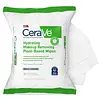What's inside
What's inside
 Key Ingredients
Key Ingredients

No key ingredients
 Benefits
Benefits

 Concerns
Concerns

 Ingredients Side-by-side
Ingredients Side-by-side

Water
Skin ConditioningIsohexadecane
EmollientIsopropyl Myristate
EmollientGlycerin
HumectantPEG-7 Glyceryl Cocoate
EmulsifyingHexylene Glycol
EmulsifyingDicaprylyl Ether
EmollientCeramide NP
Skin ConditioningCeramide AP
Skin ConditioningCeramide EOP
Skin ConditioningCarbomer
Emulsion StabilisingTriethyl Citrate
MaskingSodium Hydroxide
BufferingSodium Lauroyl Lactylate
EmulsifyingCholesterol
EmollientPiroctone Olamine
PreservativeTocopherol
AntioxidantHydroxyacetophenone
AntioxidantCaprylyl Glycol
EmollientCitric Acid
BufferingTrisodium Ethylenediamine Disuccinate
Phytosphingosine
Skin ConditioningXanthan Gum
EmulsifyingAcrylates/C10-30 Alkyl Acrylate Crosspolymer
Emulsion StabilisingBenzoic Acid
MaskingWater, Isohexadecane, Isopropyl Myristate, Glycerin, PEG-7 Glyceryl Cocoate, Hexylene Glycol, Dicaprylyl Ether, Ceramide NP, Ceramide AP, Ceramide EOP, Carbomer, Triethyl Citrate, Sodium Hydroxide, Sodium Lauroyl Lactylate, Cholesterol, Piroctone Olamine, Tocopherol, Hydroxyacetophenone, Caprylyl Glycol, Citric Acid, Trisodium Ethylenediamine Disuccinate, Phytosphingosine, Xanthan Gum, Acrylates/C10-30 Alkyl Acrylate Crosspolymer, Benzoic Acid
Water
Skin ConditioningIsononyl Isononanoate
EmollientPentaerythrityl Tetraethylhexanoate
EmollientCetyl Ethylhexanoate
EmollientIsostearyl Palmitate
EmollientCyclopentasiloxane
EmollientHexylene Glycol
EmulsifyingPEG-6 Caprylic/Capric Glycerides
EmulsifyingPhenoxyethanol
PreservativeParfum
MaskingSucrose Cocoate
EmulsifyingAcrylates/C10-30 Alkyl Acrylate Crosspolymer
Emulsion StabilisingSodium Hydroxide
BufferingPEG-4 Laurate
EmulsifyingBenzoic Acid
MaskingButylene Glycol
HumectantDehydroacetic Acid
PreservativeEthylhexylglycerin
Skin ConditioningIodopropynyl Butylcarbamate
PreservativePolyaminopropyl Biguanide
PreservativeGlycine Soja Protein
EmulsifyingWater, Isononyl Isononanoate, Pentaerythrityl Tetraethylhexanoate, Cetyl Ethylhexanoate, Isostearyl Palmitate, Cyclopentasiloxane, Hexylene Glycol, PEG-6 Caprylic/Capric Glycerides, Phenoxyethanol, Parfum, Sucrose Cocoate, Acrylates/C10-30 Alkyl Acrylate Crosspolymer, Sodium Hydroxide, PEG-4 Laurate, Benzoic Acid, Butylene Glycol, Dehydroacetic Acid, Ethylhexylglycerin, Iodopropynyl Butylcarbamate, Polyaminopropyl Biguanide, Glycine Soja Protein
Ingredients Explained
These ingredients are found in both products.
Ingredients higher up in an ingredient list are typically present in a larger amount.
Acrylates/C10-30 Alkyl Acrylate Crosspolymer is a synthetic polymer. It is used to thicken and improve the texture of products. Due to its properties, it can prevent water and oil ingredients from separating.
Benzoic Acid is used to preserve and adjust the pH of products.
The antimicrobial property of Benzoic Acid helps elongate a product's shelf life. Its main role is to reduce fungi growth and is not found to be effective at fighting bacteria. Therefore Benzoic Acid is always added along with other preservatives.
In its pure form, Benzoic Acid looks like a white crystalline solid. It has slight solubility in water.
The name of Benzoic Acid comes from gum benzoin, which used to be the sole source of deriving this ingredient. Benzoic Acid is the most simple aromatic carboxylic acid.
Benzoic Acid is naturally occuring in strawberries, mustard, cinnamon, and cloves. It has a slight scent but is not considered to be a fragrance.
Learn more about Benzoic AcidHexylene Glycol is a surfactant. Glycols are a class of alcohols. Hexylene Glycol is a surfactant and emulsifier.
As a surfactant, Hexylene Glycol helps gather dirt and oil on your skin to be washed away.
As an emulsifier, Hexylene Glycol helps keep water and oil together. This prevents them from separating in a product. Hexylene Glycol also thins out the texture of a product by lessening viscosity.
Hexylene Glycol has a small molecular weight.
Learn more about Hexylene GlycolSodium Hydroxide is also known as lye or caustic soda. It is used to adjust the pH of products; many ingredients require a specific pH to be effective.
In small amounts, sodium hydroxide is considered safe to use. However, large amounts may cause chemical burns due to its high alkaline.
Your skin has a natural pH and acid mantle. This acid mantle helps prevent harmful bacteria from breaking through. The acid mantle also helps keep your skin hydrated.
"Alkaline" refers to a high pH level. A low pH level would be considered acidic.
Learn more about Sodium HydroxideWater. It's the most common cosmetic ingredient of all. You'll usually see it at the top of ingredient lists, meaning that it makes up the largest part of the product.
So why is it so popular? Water most often acts as a solvent - this means that it helps dissolve other ingredients into the formulation.
You'll also recognize water as that liquid we all need to stay alive. If you see this, drink a glass of water. Stay hydrated!
Learn more about Water